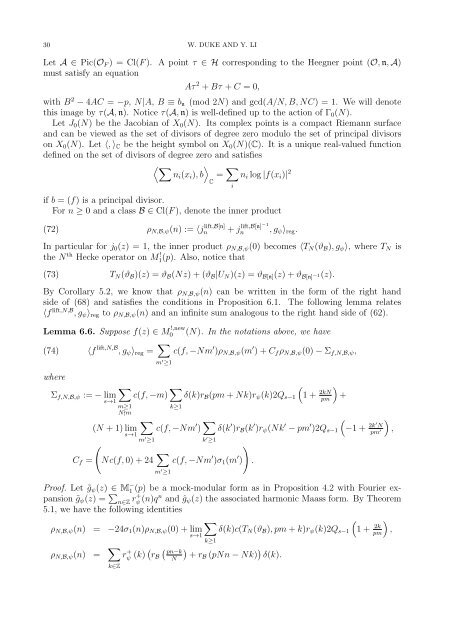Mock-modular forms of weight one - UCLA Department of Mathematics
Mock-modular forms of weight one - UCLA Department of Mathematics
Mock-modular forms of weight one - UCLA Department of Mathematics
Create successful ePaper yourself
Turn your PDF publications into a flip-book with our unique Google optimized e-Paper software.
30 W. DUKE AND Y. LI<br />
Let A ∈ Pic(O F ) = Cl(F ). A point τ ∈ H corresponding to the Heegner point (O, n, A)<br />
must satisfy an equation<br />
Aτ 2 + Bτ + C = 0,<br />
with B 2 − 4AC = −p, N|A, B ≡ b n (mod 2N) and gcd(A/N, B, NC) = 1. We will denote<br />
this image by τ(A, n). Notice τ(A, n) is well-defined up to the action <strong>of</strong> Γ 0 (N).<br />
Let J 0 (N) be the Jacobian <strong>of</strong> X 0 (N). Its complex points is a compact Riemann surface<br />
and can be viewed as the set <strong>of</strong> divisors <strong>of</strong> degree zero modulo the set <strong>of</strong> principal divisors<br />
on X 0 (N). Let 〈, 〉 C be the height symbol on X 0 (N)(C). It is a unique real-valued function<br />
defined on the set <strong>of</strong> divisors <strong>of</strong> degree zero and satisfies<br />
〈∑<br />
ni (x i ), b〉<br />
= ∑ n i log |f(x i )| 2<br />
C<br />
i<br />
if b = (f) is a principal divisor.<br />
For n ≥ 0 and a class B ∈ Cl(F ), denote the inner product<br />
(72) ρ N,B,ψ (n) := 〈j lift,B[n]<br />
n<br />
+ j lift,B[n]−1<br />
n , g ψ 〉 reg .<br />
In particular for j 0 (z) = 1, the inner product ρ N,B,ψ (0) becomes 〈T N (ϑ B ), g ψ 〉, where T N is<br />
the N th Hecke operator on M ! 1(p). Also, notice that<br />
(73) T N (ϑ B )(z) = ϑ B (Nz) + (ϑ B |U N )(z) = ϑ B[n] (z) + ϑ B[n] −1(z).<br />
By Corollary 5.2, we know that ρ N,B,ψ (n) can be written in the form <strong>of</strong> the right hand<br />
side <strong>of</strong> (68) and satisfies the conditions in Proposition 6.1. The following lemma relates<br />
〈f lift,N,B , g ψ 〉 reg to ρ N,B,ψ (n) and an infinite sum analogous to the right hand side <strong>of</strong> (62).<br />
Lemma 6.6. Suppose f(z) ∈ M !,new<br />
0 (N). In the notations above, we have<br />
(74) 〈f lift,N,B , g ψ 〉 reg = ∑ m ′ ≥1<br />
c(f, −Nm ′ )ρ N,B,ψ (m ′ ) + C f ρ N,B,ψ (0) − Σ f,N,B,ψ ,<br />
where<br />
∑<br />
Σ f,N,B,ψ := − lim<br />
s→1<br />
C f =<br />
m≥1<br />
N∤m<br />
(N + 1) lim<br />
(<br />
c(f, −m) ∑ k≥1<br />
s→1<br />
∑<br />
m ′ ≥1<br />
c(f, −Nm ′ ) ∑ k ′ ≥1<br />
Nc(f, 0) + 24 ∑ m ′ ≥1<br />
c(f, −Nm ′ )σ 1 (m ′ )<br />
)<br />
δ(k)r B (pm + Nk)r ψ (k)2Q s−1<br />
(1 + 2kN +<br />
pm<br />
)<br />
δ(k ′ )r B (k ′ )r ψ (Nk ′ − pm ′ )2Q s−1<br />
(−1 + 2k′ N<br />
,<br />
pm ′<br />
)<br />
.<br />
Pro<strong>of</strong>. Let ˜g ψ (z) ∈ M − 1 (p) be a mock-<strong>modular</strong> form as in Proposition 4.2 with Fourier expansion<br />
˜g ψ (z) = ∑ n∈Z r+ ψ (n)qn and ĝ ψ (z) the associated harmonic Maass form. By Theorem<br />
5.1, we have the following identities<br />
)<br />
ρ N,B,ψ (n) = −24σ 1 (n)ρ N,B,ψ (0) + lim δ(k)c(T N (ϑ B ), pm + k)r ψ (k)2Q s−1<br />
(1 + 2k ,<br />
pm<br />
ρ N,B,ψ (n) = ∑ k∈Z<br />
s→1<br />
∑<br />
k≥1<br />
r + ψ (k) ( (<br />
r pn−k<br />
)<br />
B N + rB (pNn − Nk) ) δ(k).
















